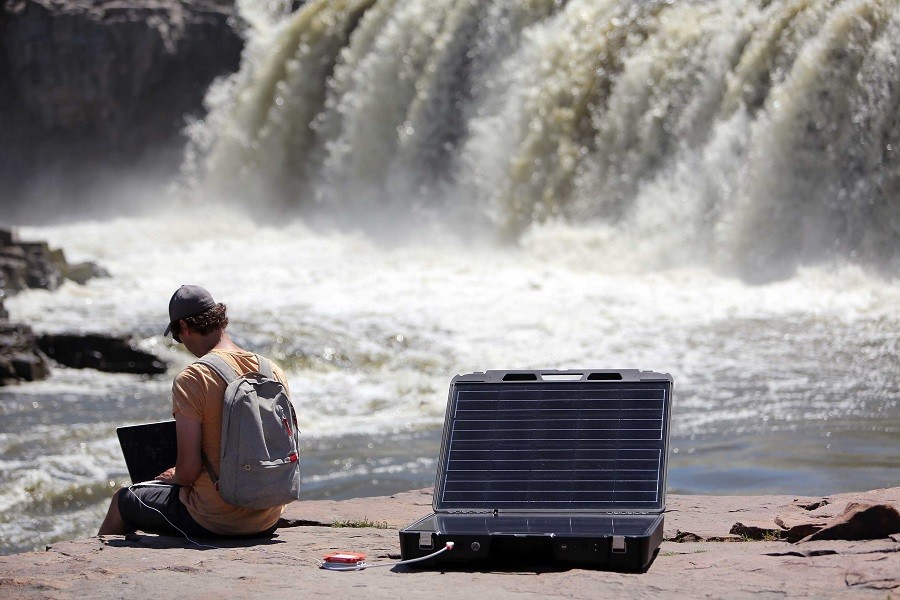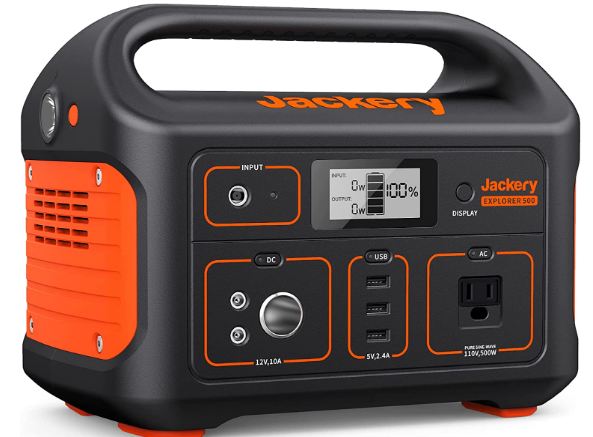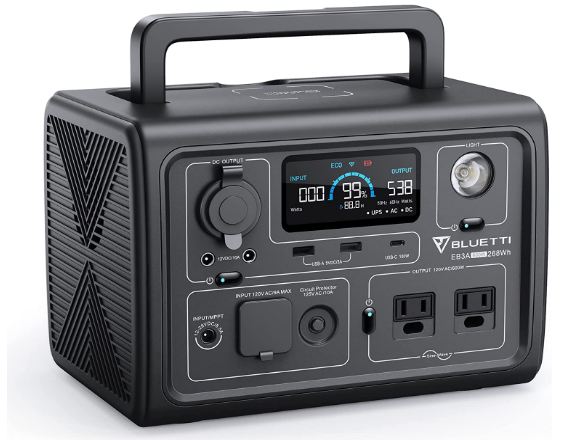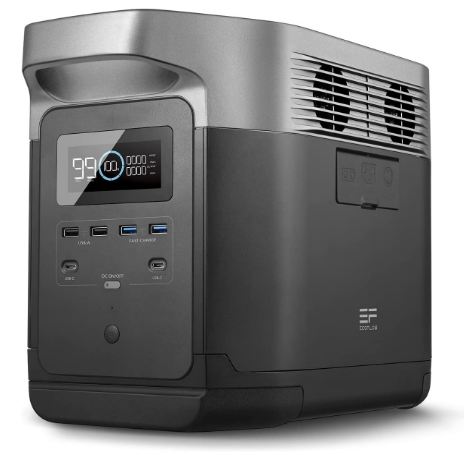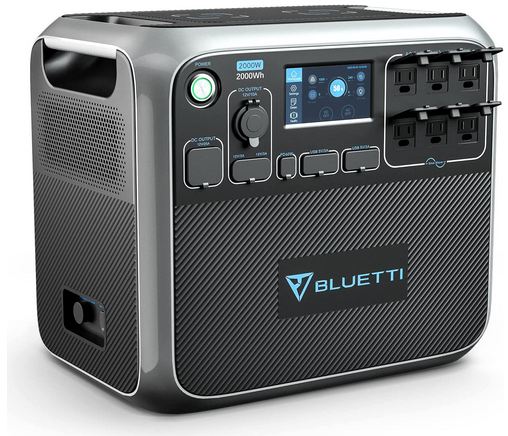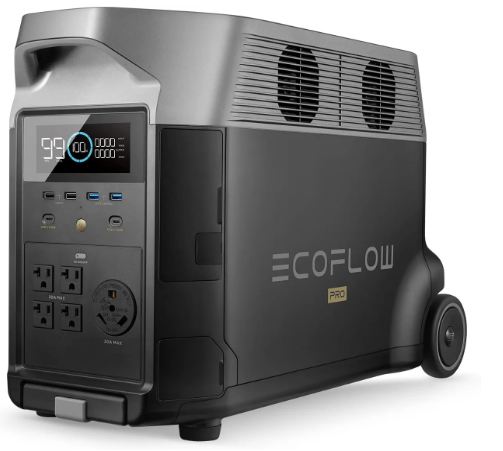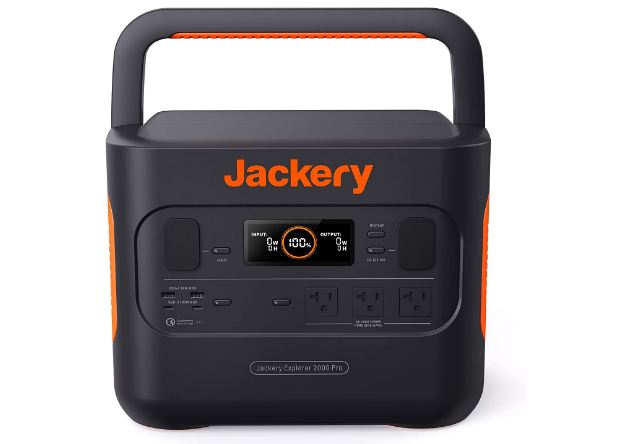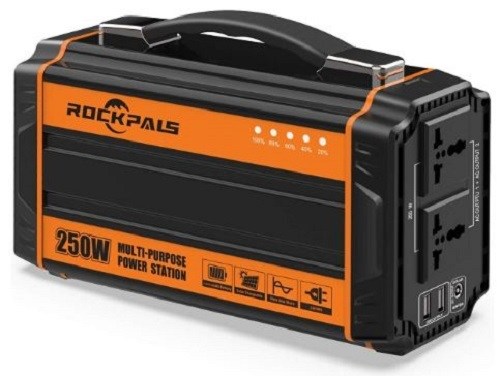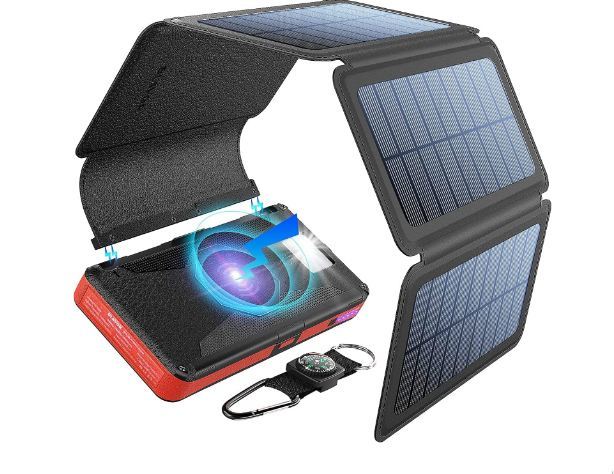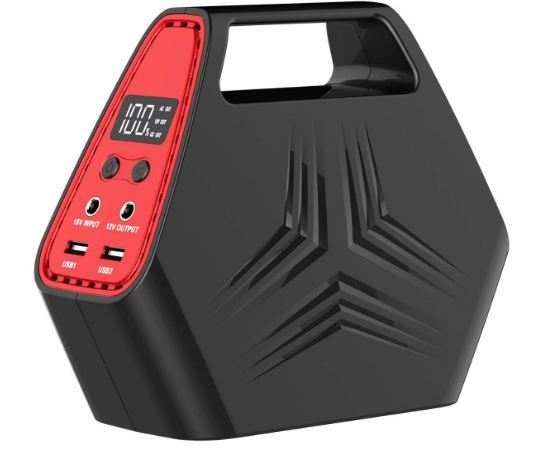Portable solar generators offer a viable and simple solution for powering devices on the go, keeping the lights on outside, recharging critical devices and providing power in emergencies.
The idea of portable generators isn't new, but recent advancements in battery and solar energy technologies have made it cost-effective to use portable generators that run on sunlight alone.
We have relied on portable gas generators for years. While effective, fuel-driven generators suffer from a few major drawbacks. Firstly, gas generators are incredibly loud.
And, they require a constant supply of fuel to keep running. If you want to be portable, that means you have to carry fuel in addition to the generator.
And wall-socket charged battery packs can keep your power on for a while, but they, too, eventually need a recharge.
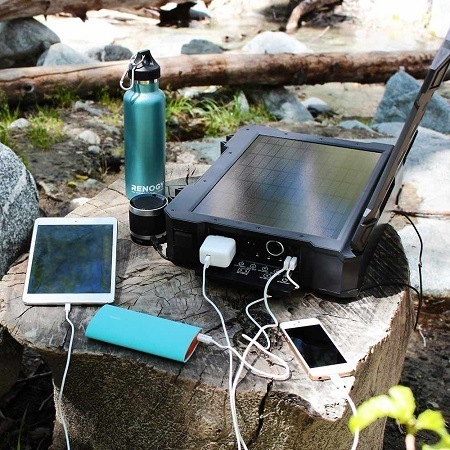
Solar portable generators are completely quiet, require no fuel and can run indefinitely wherever there is sunlight.
The portable aspect of solar generators cannot be overemphasized. You can carry power with you wherever you go, whether it's camping, a fun fishing trip or a fieldwork project.
There are plenty of solar generators today that can supply small appliances and electronics with a lot of power and can run for several hours or even days in a single charge.
This guide will walk you through what we believe are the best portable solar generator systems sold today.
Best Portable Solar Power Generator Reviews
- 1Best For Camping: Jackery Explorer 500
- 2Best for Devices & Small Electronics: Bluetti EB3A
- 3Best for Powering Small Appliances: EcoFlow Delta
- 4Best for Powering Large Appliances: Bluetti AC200P
- 5Best For Home Backup: EcoFlow Delta Pro
- 6Best Expandable: EcoFlow Delta 2
- 7Best for Truck Camping/Overlanding: Jackery Explorer 2000 Pro
- 8Best Budget: Rockpals 250-Watt Portable Generator
- 9Best Solar Power Bank: Blavor W09 Solar Charger
- 10Best Lightweight Portable Solar Generator: SinKeu 146Wh Portable Power Station

Jackery 500
Best for camping
518Wh Li-ion battery
500W output
Outlets:
AC, 12V DC, 6.5mm DC, USB-A100W solar input
7.5hr AC charge time
13.3lbs
2yr warranty

Bluetti EB3A
Best for devices & electronics
268Wh LiFePO4 battery
600W output
Outlets:
AC, 12V DC, 5.5mm DC, USB-A, USB-C, wireless200W solar input
1hr AC charge time
10.1lbs
2yr warranty
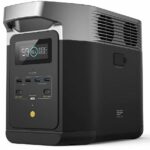
EcoFlow Delta
Best for small appliances
1260Wh Li-ion battery
1800W output
Outlets:
AC, 12V DC, USB-A, USB-C400W solar input
1.6hr AC charge time
30.9lbs
2yr warranty
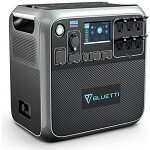
Bluetti AC200P
Best for large appliances
2000Wh LiFePO4 battery
2000W output
Outlets:
AC, 12V DC, 5.5mm DC, USB-A, USB-C, wireless, RV DC port700W solar input
4.5hr AC charge time
60.6lbs
2yr warranty
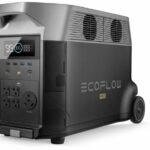
EcoFlow Delta Pro
Best for home backup
2000Wh LiFePO4 battery
3600W output
Outlets:
AC, 30A AC, DC RV port, 12V DC, 5.5mm DC, USB-A, USB-C1600W solar input
2.7hr AC charge time
99lbs
5yr warranty
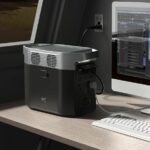
EcoFlow Delta 2
Best expandable
1024Wh LiFePO4 battery
1800W output
Outlets:
AC, 12V DC, 5.5mm DC, USB-A, USB-C500W solar input
1.3hr AC charge time
26.4lbs
5yr warranty
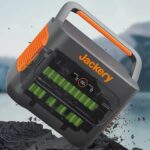
Jackery 2000 Pro
Best for truck camping & overlanding
2160Wh Li-ion battery
2200W output
Outlets:
AC, 12V DC, USB-A, USB-C1400W solar input
2hr AC charge time
43lbs
5yr warranty
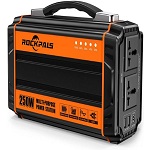
Rockpals
Best budget
240Wh Li-Po battery
250W AC output
Outlets:
AC, 12V DC, USB-A100W solar input
8hr AC charge time
5.5lbs
1.5yr warranty
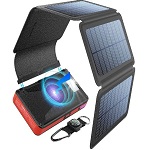
Blavor PN-W09
Best solar power bank
74Wh Li-Po battery
No AC output
Outlets:
USB-A, wireless6.5W solar output
Not specified
1.25lbs
3yr warranty
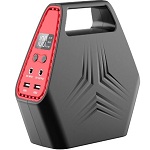
SinKeu
Best lightweight
146Wh Li-ion battery
100W output
Outlets:
AC, 12V DC, USB-A40W solar input
5hr AC charge time
3.3lbs
1yr warranty
1. Best For Camping: Jackery Explorer 500
Choosing the ideal portable solar generator for camping is a balance between portability and power.
You need a solar generator that’s powerful enough to meet all your power needs, but also light and compact enough that it easily fits in your car and you can easily carry it around by hand.
The best portable solar generator that fits this description is the Jackery Explorer 500.
With a 518Wh capacity and a 500W AC output, it’ll charge and power just about anything you carry on your camping trips. As for portability, the Yeti 500X is compact and weighs just 13.3lbs.
Pros
Cons
Our Review
Most campers carry small appliances, their gadgets and an assortment of electronics when they venture into the wild. The Jackery Explorer 500 can charge or power most of this stuff.
It packs a capacity of 518Wh, which is enough to run small appliances for several hours. In most cases, you’ll find that a single full recharge at home is enough to last you through the entire camping trip.
The Jackery 500 has a power output of 500W, which will run most camping appliances including a car fridge, CPAP, electric blanket and others.
The Jackery 500 is compact and portable, making it a great choice whether you go camping in your truck or car. It weighs 13.3lbs and includes a built-in handle.
What Can The Jackery Explorer 500 Power?
Here’s roughly how long the Jackery 500 will power various appliances and electronics (assuming you plug in only that item).
Car fridge (60W) | 7.3 hrs |
Electric blanket (100W) | 4.4 hrs |
Light (10W) | 44 hrs |
Laptop (60Wh) | 7 recharges |
Smartphone (12Wh) | 36 recharges |
CPAP (40W) | 11 hrs |
Output Options
The Jackery Explorer 500 comes with one AC outlet where you can plug in your appliances.
Since campers mostly use 12V appliances and electronics, Jackery included three 12V DC outlets on the Explorer 500.
There’s a 12V/10A car outlet (great for most 12V electronics and appliances) and two 6.5mm 12V/7A DC outlets for smaller electronics. Note that you may need a 5.5mm to 6.5mm adapter to use the two 6.5mm DC outlets.
For your rechargeable gadgets and devices, the Jackery 500 offers three USB-A outlets.
Three Recharge Options
As for recharging the Jackery 500, you have three options.
You can plug it into a wall outlet at home or wherever you can while on the road. It takes about 7.5 hours to fully recharge.
If you don't want to run out of power while camping, get a 100W solar panel. It’ll charge the Jackery 500 in about 9.5 hours (probably two days of good sunshine).
You can also plug the Jackery 500 into your vehicle’s 12V outlet to charge it while you are on the road. It takes 7.5 hours to recharge.
Limitations
Limited Output Options
The Jackery Explorer 500’s output options are a bit limited. You get just one AC outlet, meaning you cannot run more than one appliance at the same time.
It would have also been nice to get a fast-charging USB-A port and a USB-C port.
Slow Charging
Relative to newer portable solar generators in the market, the Jackery 500 charges slowly. Most solar generators these days can charge in 2-3 hours. The Explorer 500 takes over 7 hours.
2. Best for Devices & Small Electronics: Bluetti EB3A
If you need a portable solar generator to keep your devices charged and power small electronics like a CPAP, fan and mini fridge, I recommend the Bluetti EB3A.
It doesn't have much capacity (just 268Wh), but it’s good enough for devices and electronics. Its wide variety of outlets lets you charge or power just about any gadget.
Pros
Cons
Our Review
With a capacity of 268Wh, the Bluetti EB3A is one of the smallest portable solar generators you’ll find. It weighs about 10 pounds, so traveling with it is not an issue.
It’s especially ideal for those who travel or go camping with multiple gadgets like a smartphone, Kindle, tablet, drone, camera and so on.
The EB3A is also great for powering small electronics like lights, air compressor, CPAP, or a mini cooler.
You could plug small appliances like a mini fridge or even kitchen refrigerator into the EB3A, but we don't recommend it. It has an output of 600W (1200W surge), which is quite impressive for a solar generator this compact.
But because of the limited capacity, most appliances will drain the battery too quickly. The 600W output is useful for powering appliances for a short time such as making a smoothie with a 500W blender or making a cuppa in a 600W travel drip coffee maker.
Generally, the Bluetti EB3A is best for charging your gadgets and powering small electronics.
What Can The Bluetti EB3A Power?
Car fridge (60W) | 3.8 hrs |
Electric blanket (100W) | 2.8 hrs |
Light (10W) | 22 hrs |
Laptop (60Wh) | 4 recharges |
Smartphone (12Wh) | 19 recharges |
CPAP (40W) | 5.7 hrs |
Drone (77Wh) | 3 recharges |
Outlet Options For All Kinds of Gadgets and Electronics
The output interface is a big reason I recommend the Bluetti EB3A for electronics and gadgets. Most compact portable solar generators tend to have limited outlets. Not so with the EB3A.
For AC power, there are a couple of 120V sockets for running appliances and AC electronics.
For your 12V DC tools and electronics, there are three DC outlets. There’s the main 12V/10A car outlet. You also get a couple of 5.5mm (DC5521) 12V/10A outlets that are great for powering small electronics such as an internet router.
And for your smartphone and other devices, there are four charging options: two USB-A ports, a powerful 100W USB-C port, and a 15W wireless charging pad.
Fast Charging
Another surprising feature of the compact Bluetti EB3A is how fast it charges. It has a max solar input of 200W. Many solar generators of this size or even bigger have 100W or less solar input.
A 200W solar panel will charge the EB3A in 2-4 hours.
AC charging is even crazier. Max input from a wall outlet is 430W, which charges the EB3A in just an hour.
The Bluetti EB3A also has dual AC + solar charging, a feature you typically get only in larger solar generators, which recharges it in just 30 minutes.
The fast charging performance is handy when you are outdoors or on the road. You can charge or power your electronics and quickly recharge the power station and have it ready for use again in just a couple of hours or so.
Issues & Limitations
Not Suitable for Appliances
If you want a portable solar generator mostly to run appliances, the Bluetti EB3A is not the best pick.
I recommend something with a bit more capacity like the EcoFlow Delta for small appliances or the Bluetti AC200P for large appliances.
3. Best for Powering Small Appliances: EcoFlow Delta
To run small appliances like a mini fridge, water purifier, blender or small power tools, you need a portable solar generator with enough output to provide the right amount of power and capacity to last a decent amount of time.
We recommend the EcoFlow Delta. It has a capacity of 1260Wh and an output of 1800W.
Pros
Cons
Our Review
The EcoFlow Delta is great for small and medium size appliances. With a power output of 1800W it can also power larger appliances like a heater or a washing machine.
But you’ll drain the 1260Wh Li-ion too fast. That’s why we recommend it for smaller appliances like a kitchen refrigerator, a blender, car fridge, fan and so on.
It’s also great for large appliances that run for just a few minutes like a coffee maker, microwave or blow dryer.
What Can The EcoFlow Delta Power?
Refrigerator (120W) | 9 hrs |
Mini fridge (60W) | 17.8 hrs |
Water purifier (30W) | 35.7 hrs |
Laptop (60Wh) | 17 recharges |
Smartphone (12Wh) | 89 recharges |
Air purifier (100W) | 10.7 hrs |
Microwave (1000W) | 1 hr |
All The Outlets You Need
The EcoFlow Delta has a wide range of output options to cover just about any appliance, gadget or tool.
There are six 120V AC outlets, so you can run multiple appliances at the same time. There’s a single 12V/8A car output for your 12V electronics and appliances.
There are also plenty of USB - six to be specific. They include a pair of regular USB-A 5V ports, a pair of fast-charging USB-A ports, and a pair of 60W USB-C ports.
Excellent Charging Performance
EcoFlow solar generators are known for their super fast charging speeds. The EcoFlow Delta takes in up to 1200W from a wall outlet to charge to 80% in less than an hour and 100% in 1.6 hours.
Solar charging is a bit slower. Max solar input is 400W, which charges the Delta in 4-8 hours depending on the weather.
You can also charge the EcoFlow Delta from your vehicle’s 12V/24V port, but this takes 13.5 hours so it’s mostly ideal as a way to top up the solar generator when you are on the go.
Surprisingly, the EcoFlow Delta doesn't have dual AC + Solar charging. But AC charging is fast enough on its own.
Issues & Limitations
A Bit Heavy
The EcoFlow Delta sacrifices some portability to provide more power and capacity. It weighs 30.9lbs, so it’s not as easy to carry around by hand.
But you can still easily travel with it in your car or truck. It doesn't take up much space.
4. Best for Powering Large Appliances: Bluetti AC200P
To power large appliances and electronics like a kitchen refrigerator or a well pump, get a portable solar generator with at least 2kW output and 2kWh capacity.
The best one we found that’s not too bulky or expensive is the Bluetti AC200P. You can use it outdoors when camping or overlanding, power your appliances off-grid or keep it at home for emergency backup.
Pros
Cons
Our Review
Bluetti sells some of the best value solar generators in the market. Their AC200P solar generator is no exception.
It’s a solid, reliable and feature-packed 2000Wh solar generator that’s a lot cheaper than similar size power stations from many other brands.
The AC200P is a great pick if you want a good bargain on a solar generator that can run most household appliances.
Its 2000W output means you can plug in most of the stuff in your home including the kitchen refrigerator, a microwave, a washing machine and so on.
The Bluetti AC200P uses a LiFePO4 battery, which lasts much longer than regular Li-ion batteries. It can last over 6500 cycles or more than 10 years of daily use. In contrast, Li-ion batteries last about 5 years with daily use.
What Can The Bluetti AC200P Power?
Large refrigerator (300W) | 5.6 hrs |
Hair dryer (1500W) | 1.1 hrs |
Microwave (1000W) | 1.7 hrs |
Laptop (60Wh) | 28 recharges |
Three smartphones (12Wh each) | 15 recharges each |
Well pump (700W) | 2.4 hrs |
Washer (700W/cycle) | 2 cycles |
Versatile Outlets
The Bluetti AC200P has 17 outlets, more than most portable solar generators.
There are six AC outlets, so you can easily power multiple appliances simultaneously. You also get a 12V car outlet and a couple of 12V DC5521 outlets for smaller electronics.
There’s also a 12V/25A RV port that you can use to directly power the 12V circuit in your RV, motorhome or boat.
If you’d also love a 30A AC RV port, upgrade to the Bluetti AC200MAX.
For devices and gadgets, the AC200P has two 15W wireless charging pads, four USB-A ports and one USB-C PD 60W port.
Good Charging Performance
The AC200P’s charging speed is not as good as the EcoFlow Delta, but it’s still pretty good.
Max AC input from a wall outlet is 500W, which charges the AC200P in about 4.5 hours. Max solar input is better at 700W, which charges the AC200P in 3.5 hours if the weather is good.
You can combine solar + AC charging to get a 2.2hr charge time or use dual AC chargers to cut charging time to 2.5-3hrs.
You can also charge the AC200P from your car’s 12V/24V outlet or a lead acid battery (requires a special adapter).
Issues & Limitations
Heavy
The Bluetti AC200P weighs 60.6lbs. As far as portable solar generators go, that’s heavy. It’ll not be easy to carry it around by hand. I recommend setting it up somewhere in your home, RV or truck and leaving it there.
If you need to carry it over a short distance, get someone to help you or buy this trolley from Bluetti.
Note: The added weight is mostly because the AC200P uses a LiFePO4 battery. You can get 2kW Li-ion solar generators that are much lighter (like the Jackery Explorer 2000 Pro), but these have a shorter battery lifespan.
5. Best For Home Backup & Off-grid Power: EcoFlow Delta Pro
Yes, you can back up your home with a portable solar generator. The EcoFlow is especially suited to that task thanks to its massive 3600Wh capacity and 3600W output.
It’s also a great pick if you want reliable off-grid power for your cabin, tiny home, workshop or RV.
Pros
Cons
Our Review
The EcoFlow Delta Pro is massive, but still somewhat portable. It weighs 99 lbs, but has wheels so you can easily move it around your home.
It’s not ideal for camping or road trips, but it’s perfect for home backup. It has a massive capacity of 3600Wh.
It can keep essential appliances and electronics powered/charged through an hours or days long blackout.
The best part is that you can further expand this capacity to 25,000Wh by ordering extra battery packs. This is great if you want to power an off-grid home or prepare for an extended emergency.
The Delta Pro’s output is equally impressive. It produces up to 3600W of power. You can power extra-large appliances like a portable AC, a space heater or an electric range. You can also power multiple home appliances like the fridge, TV, blender, washer, coffee maker and others.
If you need even more power, the Delta Pro has a feature called X-Boost that increases output to 4500W.
What Can The EcoFlow Delta Pro Power?
Large refrigerator (300W) | 10.2 hrs |
Air fryer (1400W) | 2.2 hrs |
Microwave (1000W) | 3 hrs |
Laptop (60Wh) | 51 recharges |
Three smartphones (12Wh each) | 28 recharges each |
Well pump (700W) | 4.3 hrs |
Washer (700W/cycle) | 4 cycles |
Multiple Outlets and Home Integration
One of the reasons the Delta Pro is great for home backup is that you can integrate it directly into your home grid, so you can power appliances from your home outlets. You’ll need to order the Smart Home Panel.
Alternatively, plug appliances directly into the Delta Pro. It has four 120V/20A AC outlets plus a 30A AC outlet for home integration, RV connection, or to power large appliances that need more than 20 amps.
For 12V DC power, there’s two DC5521 ports, a 12V/10A car port, and a 12V/30A RV port.
And for devices, you get two regular USB-A ports, two fast-charge USB-A ports and two 100W USB-C ports.
Versatile Charging Options
There are several ways to charge the EcoFlow Delta Pro.
If there’s mains power, plug it into a wall outlet. AC input is 1800W and the Delta Pro charges in 2.7 hours, which is really fast for a solar generator of this size.
In an emergency, use solar charging. Max solar input is 1600W, which charges the Delta Pro in 3-4 hours on a sunny day.
You can also take the Delta Pro to any level 2 EV charging station (you’ll need a special adapter). It’ll charge in just 1.7 hours.
Other charging options include the EcoFlow smart generator, dual AC + solar, AC + solar + smart generator, and your vehicle’s 12V outlet.
Issues & Limitations
Pricey & Heavy
If you are shopping for a budget home backup solar generator, the Delta Pro is not it. It is pricey, especially once you start expanding it.
It’s also not ideal if you want a highly portable solar generator that you can use at home and away. The Delta Pro weighs close to 100lbs.
6. Best Expandable: EcoFlow Delta 2
The EcoFlow Delta Pro is expandable, but it’s too heavy and bulky for most people looking for a portable solar generator.
At 26.4lbs, the EcoFlow Delta 2 is actually portable and you can expand it from 1kWh to 3kWh.
Pros
Cons
Our Review
An expandable portable solar generator offers added flexibility. On its own, the 1024Wh Delta 2 solar generator is great for camping, road trips, fishing weekends and other uses where portability is important.
It weighs 26.4lbs, so you can carry it around with relative ease.
Add one or two extra batteries and suddenly, you have a decent home backup system. With the 3kWh max capacity, you can backup essential appliances and keep your devices charged for hours or a couple of days.
You can also use the expanded system to power select appliances in your RV, boat or off-grid cabin.
By the way, the Delta 2 comes with a longer lasting LiFePO4 battery instead of the Li-ion battery used in the original EcoFlow Delta. It lasts about twice as long.
The EcoFlow Delta 2 produces up to 1800W of power, so it can run most household appliances like your kitchen refrigerator, TV, blender and microwave.
Similar to most other EcoFlow solar generators, the Delta 2 also comes with X-Boost that increases output to 2200W, allowing you to run more appliances at the same time or heavier appliances.
What Can The EcoFlow Delta 2 Power?
Smartphone (12Wh) | 72 recharges |
Light (10W) | 87 hrs |
Microwave (1000W) | 48 mins |
Laptop (60Wh) | 14 recharges |
Car fridge (60W) | 14.5 hrs |
CPAP (40W) | 21.7 hrs |
TV (100W) | 8.7 hrs |
15 Outlets
The Delta 2 has no shortage of outlets.
You can plug appliances into one of the six AC outlets and power your 12V electronics from the 12V/10A car outlet or the two DC5521 12V/3A outlets.
To charge smartphones and other gadgets, the Delta 2 comes with two 100W USB-C ports, two 12W USB-A ports and two fast charge 18W USB-A ports.
Fast Charging
Whether you are using solar panels or a wall outlet, the Delta 2 recharges super fast, ensuring the solar generator is ready for use in no time.
Max solar input is 500W, which is pretty good for a 1kWh solar generator. A 500W array can recharge the Delta 2 in just 3 hours if the weather is right.
Max AC input is even higher at 1200W. A wall outlet will take Delta to from 0 to 80% in just 50 minutes. A full recharge takes 80 minutes.
Delta 2 also comes with a car charging cable.
Issues & Limitations
Pricey Battery Packs
The Delta 2 is actually a pretty good bargain compared to other 1kWh solar generators. But the extra batteries are not cheap. Each costs almost the same as the solar generator.
If you are planning to expand the Delta 2 solar generator to the max 3kWh, the total cost will be over $2,500.
Luckily, you can buy the solar generator first and add the extra batteries later, maybe even one at a time.
7. Best for Truck Camping/Overlanding: Jackery Explorer 2000 Pro
If you often go on truck camping and overlanding trips, you probably travel with more electronics and appliances.
Luckily, you can afford to carry a bigger and more capable solar generator like the Jackery Explorer 2000 Pro.
It’s big enough to run multiple appliances, but not too bulky that it takes up a lot of space. It’s also light enough to carry to and from the campsite.
Pros
Cons
Our Review
The Jackery Explorer 2000 Pro is an upgrade to the highly popular Explorer 2000. In the Pro model, Jackery has slightly increased capacity, added more outlets and increased charging performance.
The Explorer 2000 Pro has a capacity of 2160Wh and an output of 2200W. It can power most appliances while also running 12V electronics and charging devices.
This capability is what makes the 2000 Pro great for truck campers and overlanders. Regardless of which electronics, tools, gadgets and appliances you travel with, the Explorer 2000 Pro can handle them all.
And it does this without taking up much space or being too heavy. It measures 15.5"L x 8.1"W x 10.2"H and weighs 43lbs.
What Can The Jackery Explorer 2000 Pro Power?
Electric blanket (100W) | 18 hrs |
Mini fridge (60W) | 30.6 hrs |
Water purifier (30W) | 61.2 hrs |
Laptop (60Wh) | 30 recharges |
Smartphone (12Wh) | 153 recharges |
Drone (70Wh) | 26 recharges |
Fan/light(10W) | 183.6 hrs |
Versatile Outlets
The Jackery Explorer 2000 Pro has the outlets you need to keep all your stuff running or charged.
There’s three AC outlets for appliances, a 12V/10A car outlet for 12V electronics (no 5.5mm outlets, unfortunately) and four USB ports for devices (two fast charge USB-A and two 100W USB-C).
Fast Charging
Another reason we recommend the Jackery 2000 Pro for overlanders and truck or van campers is how fast it charges - with either solar or AC.
Plug it into a wall outlet and it charges in just 2 hours. That’s impressive for a 2000Wh+ solar generator. So if you are at a hotel or campsite with power outlets, you can quickly recharge your solar generator.
Max solar input is also impressive at 1400W, which can charge the 2000 Pro in about 2.5 hours. If you get enough solar panels, you can be sure the solar generator will be able to recharge fully before the end of the day.
There’s also a car charging option, but it takes forever so it’s only suitable for topping up on the go.
Issues & Limitations
Li-ion Battery
If you plan to use the Jackery Explorer 2000 Pro occasionally when you go on your adventures, the li-ion battery inside will serve you for a long time. It can last up to 10 years.
But if you are on the road daily or multiple times a week, the Explorer 2000 Pro may not last long since you’ll cycle the battery more frequently.
The li-ion battery has a lifespan of 2000-3000 charge & discharge cycles, so the quicker you burn through them, the sooner the battery - and the solar generator - will die.
For frequent use, I recommend a LiFePO4 solar generator like the Bluetti AC200P. It has a lifespan of 6500+ cycles.
8. Best Budget: Rockpals 250W Portable Generator
The Rockpals portable generator boasts a 250W battery that's powerful enough to charge most small electronics, including smartphones, tablets, and laptops.
It can also power a TV, mini-refrigerator, and lights.
If you are looking for an affordable but capable camping or small home backup solar generator, this one will serve you well.
Pros
Cons
Our Review
Features
240Wh LiPo battery: The lithium polymer battery holds 64,800mAh of charge at 3.7V and 18,500mAh at 12V.
That's enough to charge and power most electronics from devices like smartphones to small appliances such as CPAP machines.
The battery management system prevents overcharging and short-circuiting while also watching out for high temperatures.
250W pure sine wave inverter: The high-wattage inverter allows you to plug a wide range of small appliances into the AC outlet, including a CPAP machine, a small coffee maker, a 32" TV, or a car mini-fridge.
The inverter provides 300W of surge protection.
Multiple outlets: You get two 120V AC outlets, four 12V DC ports, and two 5V USB outlets.
Three recharge options: For camping, fishing, hunting, and other outdoor activities, the easiest way to recharge the battery is using a 60W or 100W solar panel (not included).The solar generator has a built-in MPPT charge controller, so you just need to buy the solar panel.
If solar charging is not an option, you can also recharge the battery via a wall outlet or from your car's 12V DC socket. A wall charger and car charger are included.
Lightweight: As solar power stations go, the Rockpals 250W generator is pretty light. It weighs just 5.5lbs, making it perfect for camping, road trips, and other outdoor uses.
A Versatile Solar Generator
The Rockpals solar power station is not just for campers and outdoor enthusiasts. It's also a great home power backup solution for smartphones, laptops, and small appliances.
It can also be used in emergency areas, for fieldwork, or even in boats and RVs.
Limitations
The Rockpals solar generator doesn't come with a solar panel. If you plan to use it outdoors for extended periods, budget for a 60W or 100W solar panel.
Remember, you don't need to get a charge controller. The solar generator has one built-in, a highly efficient MPPT type at that.
Summary
The Rockpals 250W solar generator is a great choice for anyone looking for an affordable high-capacity solar power station that can power or charge small and mid-size electronics.
9. Best Solar Power Bank: Blavor PN-W09 Solar Charger
A solar power bank is a good choice if you want a highly portable solar generator for charging your phone and other devices.
The BLAVOR solar charger comes complete with foldable solar panels, so you can easily recharge it when outdoors.
Pros
Cons
Our Review
Features
20,000mAh power bank: While nowhere as big as other solar generators, the BLAVOR solar power bank is large enough to charge a smartphone multiple times over.
If you just need to charge your smartphone and maybe a couple other devices while outdoors, the BLAVOR is much more convenient to carry compared to a bigger and heavier power station.
Three output options: The BLAVOR solar charger comes with two USB-A ports, one of which has fast charging. There’s also a 5W wireless charging pad for QI-enabled devices.
The Blavor power bank has a USB-C port but it’s only for charging the power bank. It doesn't have any output.
Detachable solar panels: Most solar power banks come with a single solar panel integrated onto its surface. It takes forever to recharge the power bank.
In contrast, the Blavor power bank has a built-in solar panel plus four foldable solar panels that attach magnetically to the power bank.
You can fully recharge the Blavor power bank with the sun in just a few hours. So you can go hiking or camping and charge your phone as often as you want.
Note that you can also charge the power bank via the USB-C port.
Great For Hiking & Backpacking
Unlike most portable solar generators, the Blavor solar power bank is actually something you can carry with you when hiking or backpacking.
The entire kit weighs just 1.2lbs.
The Blavor solar power bank has a couple of accessories that will be handy outdoors: a built-in flashlight and SOS light, and a small compass with a carabiner.
Limitations
The Blavor solar power bank doesn't seem to be waterproof, dustproof, or drop proof. The manufacturer doesn't provide an IP rating.
So you have to be careful when using it outdoors.
Summary
The Blavor W09 solar charger is a great choice for anyone looking for a solar-charged power bank that comes with solar panels.
Avoid it if you want a hardier solar power bank for extreme outdoor activities. Also not ideal for those who prefer the larger capacity of a power station.
10. Best Lightweight Portable Solar Generator: SinKeu 146Wh Portable Power Station
If you want a lightweight solar generator, but don't want to get a powerbank, we recommend the SinKeu portable power station.
It weighs just 3.3lbs but includes AC, DC, and USB outlets.
Pros
Cons
Our Review
Features
146Wh Li-ion battery: This is one of the smallest capacity solar generators you’ll find. It’s the reason the SinKeu power station is so light.
But the 42,000 mAh capacity is plenty enough to charge devices several times over. You can also run low-wattage appliances for short periods.
100W pure sine wave inverter: Despite its size, the SinKeu power station has an AC inverter that feeds power to two AC outlets.
The max AC output is 100W, so you are limited to low power appliances like a fan, personal humidifier, or a small TV.
Dual USB outlets: The two USB-A outlets on the SinKeu power station have Quick Charge 3.0. There’s no USB-C port.
One DC outlet: The final output option is a 12V DC car port for running DC-powered tools, appliances, and lights.
Three recharge options: Similar to the larger solar generators, you can recharge the SinKeu power station via solar, a wall outlet, or a vehicle’s 12V port.
Highly Portable Power Station
The SinKeu power station is one of the few solar generators that’s light enough to take hiking and backpacking.
It weighs just 3.3lbs and can easily fit in a backpack.
Limitations
If you are buying a portable solar generator mostly for powering appliances, we do not recommend the SinKeu power station.
It’s 100W max output limits it to very low wattage appliances.
Summary
The SinKeu portable power station is a great choice for anyone looking for an extra-light and highly portable solar generator.
Avoid it if you want a portable solar generator that can power a wide range of appliances.
How Do Portable Solar Generators Work?
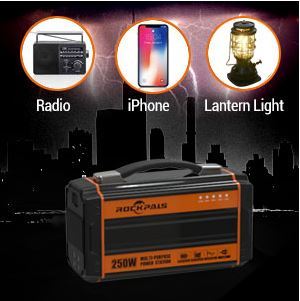
A portable solar generator is essentially a miniature version of a full-size solar system that’s installed in homes.
Instead of large panels on the roof and a high-capacity battery bank in the house, a portable solar generator captures power using smaller solar panels.
You can get a generator with the panel's built-in, but most come without solar panels. You have to buy your own and connect them to the solar generator.
Power from solar panels is stored in a built-in battery; usually, a lithium-ion battery through lead acid battery solar generators are common too.
Most solar generators have a built-in charge controller to monitor and control current from the solar panels. This ensures the battery charges efficiently and safely.
When you plug an appliance into the solar generator’s AC outlet, an inverter converts DC power from the battery into usable AC output.
Most portable solar generators also have multiple USB ports for charging smartphones and other devices as well as a 12V DC port for things like lighting, CPAP machines, and power tools.
Portable Solar Generator Buying Guide
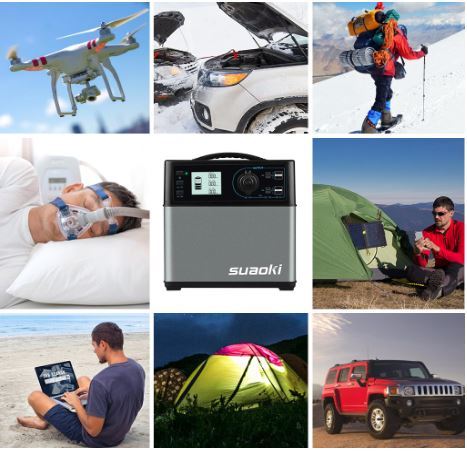
1. Portability
When it comes to solar generators, portability is relative.
If you are looking for something to charge your phone when hiking, you want the lightest solar charger you can get, ideally around 1lb or lighter.
If you are a camper, you are probably looking for a higher capacity power station that can power some appliances while also charging your phone.
Since you'll mostly be carrying it in your truck, you can afford to get something heavier. But it should not be too heavy that you cannot carry it from the vehicle to the camping site on your own. Ideally, it should weigh under 20lbs.
A home backup solar generator, on the other hand, can be much heavier without affecting usability. You can get a power station weighing 50lbs or more.
2. Battery Type and Capacity
Look for solar generators with lithium batteries – lithium-ion, lithium polymer or lithium iron phosphate (LiFePO4).
These are the best types of batteries. They pack a lot of power in small size and have a long lifespan compared to lead acid batteries.
Of the three types of lithium batteries, LiFePO4 are the longest-lasting, though they are heavier.
As for battery capacity, it'll depend on your needs.
If you just need to charge your smartphone and other devices like a tablet or camera, a low capacity power station (less than 300Wh) will do.
You can even forgo the batteries and get a foldable solar charger that directly charges your phone without storing power.
If you need to charge many devices (multiple smartphones, cameras, drones, a laptop, etc.), get a higher capacity power station (at least 300Wh).
If you need to power some appliances, you can get a 300-500Wh solar generator if they are small appliances (e.g., router, fan, CPAP, mini-fridge, etc.) or a much bigger generator (up to 3,000Wh or more) for larger appliances like a kitchen fridge, TV, coffee maker, and power tools.
3. Power Output
The power output of the AC inverter in a power station determines how much power you can draw from it.
The inverter typically has two ratings: the continuous power rating (the power it can provide continuously) and the surge rating (the startup power it can provide, usually for just a few seconds).
When shopping for a solar generator, look at the wattage of the biggest appliance; you plan to power with the generator.
Then look for a solar generator with an AC inverter with a higher continuous wattage.
Also, check the startup wattage of your appliances and ensure it doesn't surpass the inverter's surge rating.
Note: Inverters are only found on solar generators that have an AC outlet. If you are planning to get a USB-only solar charger, don't worry about the inverter power rating.
4. Solar Panels
Check if the solar generator comes with solar panels. If it does, check how much power they output. It'll give you an idea of how quickly they will charge your device or battery.
If you get a power station without solar panels, you can usually charge it through a wall outlet or your car's cigarette lighter socket.
But if you are planning to use it outdoors for extended periods, we highly recommend buying a couple or so solar panels.
Best Value: Renogy 100W Portable Solar Panels

We recommend RENOGY 100 Watt solar panels. They offer the best value for your money.
The panels come in a set of 6, giving you up to 600W of power. That's enough to charge a power station as large as the Goal Zero Yeti 3000 in a few hours.
The panels are easy to rig together using the included MC4 connectors. They can withstand high winds and heavy snow loads.
5. Charge Controller
Most solar power stations have a built-in solar charge controller. Some solar panel kits also come with an external solar charge controller.
MPPT charge controllers are the best. They reduce energy wastage, which charges batteries faster even in low sunlight conditions.
But they can significantly increase the price of the power station. If you are on a budget, a solar generator with a PWM charge controller is still okay.
If you are buying an expansion solar panel kit, you may need to get your own charge controller. In that case, just get an MPPT controller. There are some affordable ones in the market.
Best Value Charge Controller: OOYCYOO MPPT

The OOYCYOO MPPT charge controller can handle up to 60 amps of current and 100V of voltage, which is impressive for its price.
It's perfect for use with small and medium-size solar systems in RVs, boats, and other areas.
An LCD display lets you track power input and battery voltage.
It is compatible with sealed, gel, and flooded batteries but not lithium batteries.
6. Output & Input Options
If you are buying a solar phone charger, a couple of USB outlets are enough.
If you are getting a larger power station for camping or home backup, it should offer USB, AC, and DC charging options.
The number of each depends on the power station's capacity and power needs. Lower capacity generators usually have one or two of each while high-capacity power stations like the EcoFlow Delta Max have more than a dozen output options.
Pro tip: Check if the solar generator offers USB-C and Quick Charge-enabled USB ports.
As for input options (recharging the battery), a solar input port is a must. Most power stations also offer the option to recharge from a wall outlet as well as a car's cigarette lighter socket.
If the power station offers these extra options, check if it comes with a wall charger and a car charger. Some also come with a solar panel cable.
Don't forget to check the charging performance. You don't want a portable solar generator that takes forever to recharge.
The bigger the capacity of the solar generator, the higher it's solar and AC input should be.
Generally, a good portable solar generator should charge fully from a wall outlet in under 4 hours regardless of capacity.
Solar charging should be under 6 hours to ensure it can recharge before the sun sets, ensuring you have enough stored power for the night.
7. Extra Features & Options
Here are some extras that are nice to have.
Display: It makes it easy to track power input/output and see the remaining battery charge.
Wireless connectivity: Either Bluetooth or Wi-Fi. It allows you to monitor the solar generator from your smartphone. Wi-Fi connectivity is the best since you can monitor and control the solar generator from anywhere. Bluetooth is limited by range.
Flashlight: Some solar generators come with an integrated flashlight that you can also use to send an SOS alert.
Installation & Setup of a Solar Generator
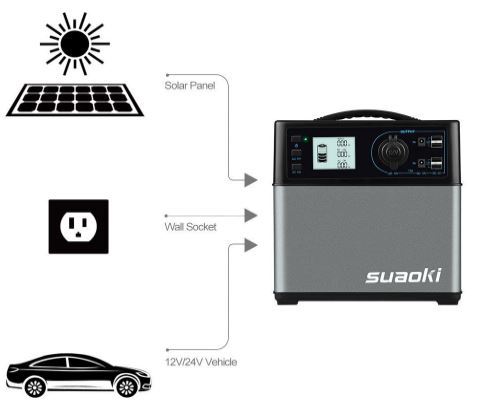
Installing an Off-Grid Solar Generator System
A standalone solar generator (one that isn't connected to the mains) doesn't need any installation. You simply charge the built-in battery and then plug in your devices or appliances.
Most come with a wall adapter and car charger for recharging the battery. You can also recharge it using solar panels, which are typically not included.
Note that when you buy solar panels, you usually don't need to buy a charge controller. Most solar generators come with a built-in solar charge controller.
However, if you are buying a solar expansion kit to charge your boat, RV, or backup batteries, you'll need to have a charge controller. We recommend an MPPT charge controller. It delivers more power to batteries compared to PWM controllers.
Most standalone solar generators also come with a built-in DC-AC inverter.
Installing a complete home backup solar generator is much more involving (and expensive). You'll need to install enough solar panels on the roof and connect them to a charge controller.
The charge controller then delivers power to the battery bank. The deep cycle batteries then connect to the breaker box (via an inverter) to power your home.
Installing an On-Grid Solar Generator System
An on-grid or grid-tied solar generator system is cheaper to install since it doesn't need a battery bank, usually the most expensive component of an off-grid system.
An on-grid solar generator system returns excess electricity back to the utility grid, reducing your power bills.
You'll need to install solar panels on the roof and connect them with a grid-tie inverter. The inverter converts DC current from the solar panels to AC current that has the same frequency as the one supplied by the utility grid.
You'll also need a power meter that provides net metering. It measures the power coming in and going out.
Solar Panel Installation
Before installation, make sure the roof is in good condition. Installers will come for a pre-installation site visit that may also include an assessment of your electrical panel.
Depending on the size of the solar system, you may need to upgrade the breaker panel to handle more current and voltage.
Racking will then be installed on your roof, and the panels secured on top of them.
Smaller systems consisting of just one or two panels are much easier to install. You usually don't need any racking; just brackets to hold the panel to the roof of your house, RV, or boat.
Solar panels for portable solar generators don't need any installation at all. Just position the solar panels on the ground or platform to capture full sunlight.
Some generators use a foldable solar panel system. You unfold the panels to capture direct sunlight.
Note: You'll need to decide whether to wire your solar panels in series (increases voltage) or parallel (increases the current). The right choice depends on your inverter, charge controller, and battery bank. You can also connect them in both series and parallel to maximize voltage and current.
Advantages of a Solar Powered Generator
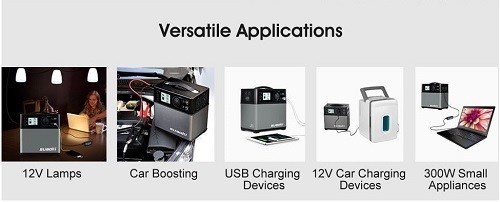
Environmentally Friendly
A solar-powered generator uses renewable energy from the sun. This greatly reduces the number of fossil fuels burned, which cuts down on the amount of carbon released into the air.
Unlike a gas generator, a solar-powered generator does not produce any pollutant fumes. It's not just safer for the environment; it's healthier for your family as well.
Long-Term Savings/ROI
A high-capacity solar powered generator can be pricey to buy and set up. But you'll make your money back in a few years in terms of long-term power savings.
Whether you install an off-grid or grid-tied system, you'll get a healthy return on investment (ROI).
Indoor Use
It's not just the noise from traditional gas generators that make them awful for indoor use; the fumes they produce can be hazardous.
If the room is not well ventilated, carbon monoxide poisoning is a real risk.
In contrast, a solar generator is silent and doesn't produce any gasses. You can have it right next to your bed without any danger.
Noiseless
Don't be that neighbor who fires up their noisy gas generator whenever there's a blackout. Gas-powered leaf blowers are annoying enough as it is.
A portable solar generator can provide the same power as a comparable gas generator without any of the noise.
Ease of Use and Convenience
With a solar generator, you don't have to worry about buying gas and adding it to the generator. If you need to charge the battery, just connect it to solar panels or a wall outlet.
You can use a solar generator anywhere in the house, and most are portable, meaning you can use it outdoors or on camping trips.
Solar Backup Generators Vs. Portable Solar Generators: What's the Difference?
The difference between solar backup generators and portable solar generators comes down to size and power output.
Solar backup generators are designed to run appliances – including large ones like a fridge – for several days after a power blackout.
These generators are big, heavy and have a high wattage. They also have a large battery to store lots of power. Most also allow chaining with other batteries to expand capacity.
Portable solar generators, on the other hand, are lighter and more compact. This makes it easier to carry the generator when going camping or an RV roadtrip.
Because of their smaller form factor, portable generators have smaller batteries that are suited to powering small appliances and charging devices. Most also have a lower output AC inverter.
Note that some solar generators overlap the backup and portable categories. For example, the Goal Zero Yeti 3000X and 6000X solar generators are powerful enough to provide home backup power, yet small enough to carry in your truck or RV when going on outdoor adventures.
Portable Solar Generators: Frequently Asked Questions

Can a portable solar generator power a house?
No, it cannot. Even a large backup solar generator cannot power everything in the house. The batteries don’t hold enough charge to power multiple appliances at once.
Solar generators are also not powerful enough to power things like central air conditioners and ovens.
If you want to power your whole house with solar, consider installing a full-size solar system.
Can you run a TV on a portable solar generator?
Yes, most portable solar generators can run a TV for several hours. It’s important to check the TV’s wattage. Different types and sizes of TVs consume varying amounts of power.
If a portable solar generator has a 250W continuous AC inverter, you cannot connect a TV that is higher than 250W.
The good news is that modern TVs have gotten very efficient. Large modern TVs actually use less power than smaller sets from the 90s. So you should be able to power a 40” TV with a basic 200W portable solar generator.
Can you power a refrigerator using a portable solar generator?
It depends on the battery capacity and per output of the generator.
Check the wattage of the refrigerator and make sure it is equal to or less than the continuous output from your generator’s AC inverter.
However, even if your solar generator can handle your fridge’s wattage, the battery may not be big enough to last more than an hour or two.
We recommend high-capacity solar generators like the Goal Zero Yeti 3000 for standard kitchen fridges and smaller portable generators for mini-fridges such as those typically used for camping.
How does a portable solar generator works?
A portable solar generator is essential a battery within a housing that has additional components like outlets, a small display and a charge controller.
You recharge the battery using portable solar panels. You then plug in appliances and devices into the generator to draw power.
Note that most solar generators can also be recharged from a car charger or a wall outlet.
Can a portable solar generator power a house?
Maybe a few essential appliances but not the entire house.If you want to power everything in your house, consider setting up a solar backup system consisting of an extensive battery bank and rooftop solar panels.
Can I use AC with solar power?
Yes, you can. Portable solar generators have a built-in AC inverter and one or two AC outlet where you can plugin AC-powered appliances. Just make sure not to exceed the wattage rating of the inverter.
For home backup systems connected to your home electrical system, you’ll need to install an AC inverter to get AC power from your solar backup system.

